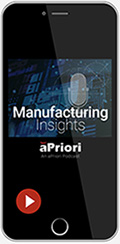November 24, 2025
Technology for Smarter Sourcing Decisions

Transcript
How can manufacturers balance costs, delivery, and quality when choosing suppliers? And where can they get the real-time data they need to know whether those suppliers will actually deliver?
Jody Markopoulos has spent over 30 years leading operations teams across multiple industrial sectors. In this conversation, she explains how to give sourcing and procurement the technical insight they need to understand what truly drives product cost, supplier performance, and total landed cost.
Accelerate Options and Choices
Jody Markopoulos: For industrial manufacturers, aPriori accelerates your options and choices. aPriori gives you a lot of information about where you are today from a cost perspective, as well as the optionality of where you can go with it and what areas to investigate.
Key Information for Sourcing and Procurement:
- Cost. What is the cost of my good or the cost to service my good?
- Delivery. Cost and delivery go hand in hand. I can have a lower cost, but if I can’t get it delivered because the cycle time required to get that lower cost—i.e., how it’s manufactured—changes, then that lower cost doesn’t help me.
- Quality standards also factor in.
It’s a composite of total landed cost—or the total cost associated with the good that I’m purchasing. I include services in there too, because there’s a world of spare parts, a world of servicing that part, and all of that affects the total cost of the relationship with that supplier.
Sourcing professionals are responsible for the total relationship and performance of a supplier. Using the aPriori tool to help optimize all three elements of that relationship is important.
Is Cost The #1 Role of Procurement?
Some people think that the role of procurement is just to get the best cost. Sometimes the best cost isn’t the best decision. It’s a comprehensive view of the cost, the availability—i.e., delivery—and the quality performance of that supplier.
If I go and buy 10 products from somebody, but four out of the ten fail, then I don’t have them—and my customer doesn’t have them. So it’s that composite view. I feel strongly that the aPriori platform gives you insights at a detailed level to help you make the best cost decisions while also considering delivery and quality performance as you make the choice to talk to that supplier. As you use the tool as a benchmark to discuss with the supplier, you’re developing deeper dialogue about what it takes to manufacture your part and why it matters. It’s more time spent on the relationship than just on the transaction.
I think the number one element of being a more effective negotiator is truly understanding the technical aspects of what you’re negotiating.
Technical Aspects of Negotiation:
- How is it made?
- What is it made from?
- What does it take to make it—i.e., the cycle time?
- And where can I find locations across the globe that can do those types of operations to yield my product?
Somebody new coming into the industry isn’t inherently there yet. They might have the right motivation, and great communication and organizational skills, but they don’t have that technical aptitude. I think the tool— aPriori’s tool—gives them a level of technical aptitude and information about what to look at in terms of what drives the overall cost of that good or product.
Continuous Improvement
I think engineering and procurement can think about the use of aPriori as a continuous improvement loop. You work hand in hand. When engineering designs something new—new features, new products—they’re looking for feedback. They’re looking for feedback on whether it’s manufacturable, yes or no, and whether it’s within the cost budget of what we expect to sell it for. That’s where the team approach comes in. People have to look at this not as one function or the other, but as a team approach to introducing that part.
In a perfect world, we’d love to put everything through, but we know that’s not feasible. So I would prioritize it around the KPIs: Where do I know I have my largest costs that drive my overall product cost?
AI = Accelerating Innovation
I’d rephrase AI as “accelerating innovation.” I think one of the biggest use cases for AI is productivity—accelerating learning, accelerating time to market, and accelerating cost-out. Just think about the use of that data and applying powerful analytics to it to learn from it—whether it’s educating your team or making better, faster decisions with the information.
It’s an accelerant. So I think thinking about it not as artificial, but as an accelerator, is a great way for people to understand the power of it.







